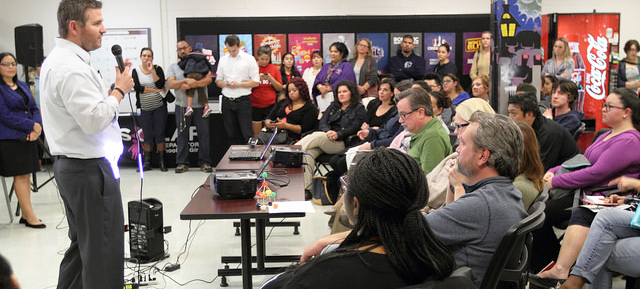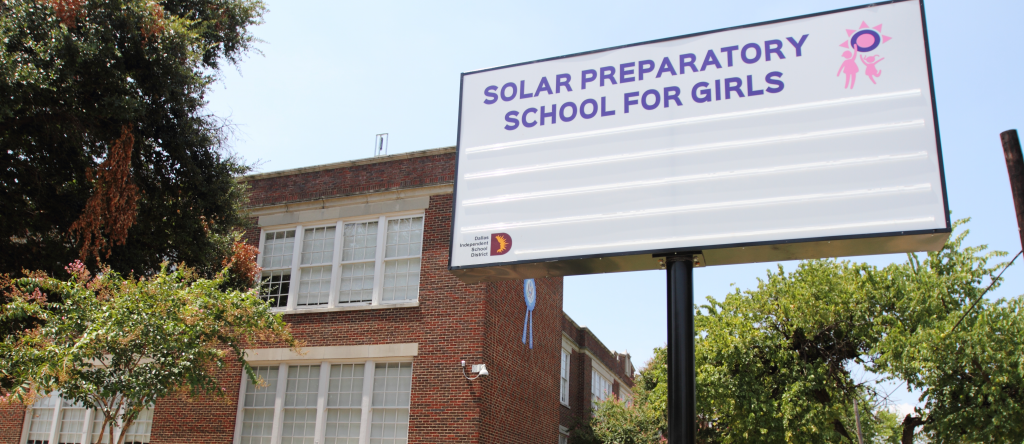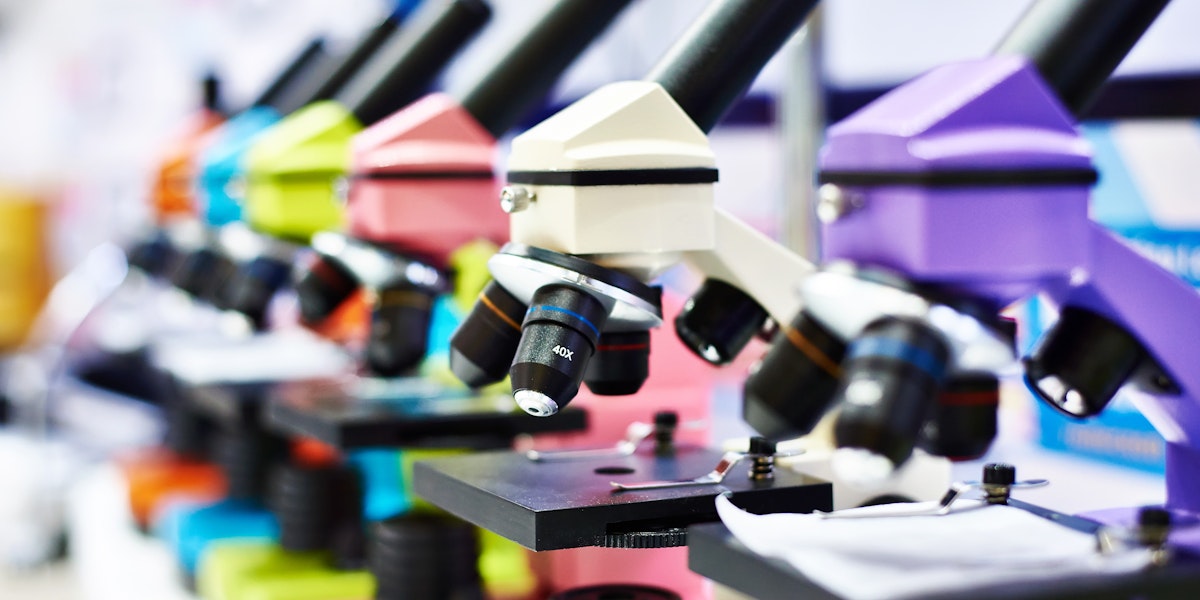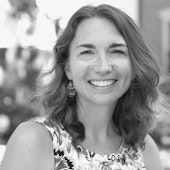Dallas is a large metropolitan area in northern Texas; according to the 2015 Census,1 it is the ninth most populous city in the country with more than 1,300,000 residents. Dallas is also a diverse city socioeconomically. While the median household income is $43,359,2 there is a vast range across Dallas neighborhoods. In the M Street neighborhood of north Dallas, the median income is over $93,000, while in parts of south Dallas, it is less than $15,000.3 This socioeconomic diversity is not present in the schools, however, as 89.6 percent of public school students in Dallas are economically disadvantaged using the federal poverty guidelines based on free and reduced-price lunch eligibility, according to the DISD Office of Institutional Research.4 In terms of race, 22.6 percent of students are black/African American, 0.3 percent are American Indian/Alaska Natice, 1.4 percent are Asian/Hawaiian/Pacific Islander, 70.4 percent are Hispanic, 4.7 percent are white, and 0.5 percent represent multiple groups.5
Given the rich diversity of the city, the Dallas, Texas Independent School District (Dallas ISD) is taking its own unique approach to school integration by designing an innovative school choice pilot. This new program consists of a small number of new or transformed schools designed to enroll students from different backgrounds and attract more middle-class families back to the district.
History of School Integration Efforts in Dallas
Dallas began the work of desegregation in 1971 when a parent, Sam Tasby, sued and won a district court case, Tasby vs. Estes, against the Dallas ISD. Tasby’s class action lawsuit claimed that the city’s schools were segregated and that the schools children of color attended did not receive equitable funding and resources. As a result, a federal desegregation order was placed on the schools. Under the court order, students were bused around the city to ensure equal access to a quality education. However, when the district was deemed unitary in 2003, students again began to attend their neighborhood schools.6 As Dallas’s housing has long been segregated by race and socioeconomic level, and given that the school attendance boundaries are once again based on zip code, the majority of Dallas children now attend segregated schools.7
Stories of School Integration
View the profiles of school districts and charter schools pursuing socio-economic integration.The Future of Brown Is Multiracial
How My Family’s Immigration Story Connects to Integration
New York City Public Schools: Small Steps in the Biggest District
Chicago Public Schools: Ensuring Diversity in Selective Enrollment and Magnet Schools
Hartford Public Schools: Striving for Equity through Interdistrict Programs
Stamford Public Schools: From Desegregated Schools to Integrated Classrooms
Dallas Independent School District: Integration as Innovation
Jefferson County Public Schools: From Legal Enforcement to Ongoing Commitment
Eden Prairie Public Schools: Adapting to Demographic Change in the Suburbs
Champaign Schools: Fighting the Opportunity Gap
The Current Plan
In the past couple of years, Dallas has devoted new energy to addressing the problem of segregation through its work on public school choice. In 2014, Dallas ISD developed a new incubator called the Office of Transformation and Innovation (OTI), which focuses on, among other pilot projects, expanding choice options in the district. While school integration is not explicitly part of the office’s charge, Mike Koprowski, the district’s chief of transformation and innovation, sees diversity as essential to achieving their goal of boosting achievement through innovative programs. While Koprowski began his career in the Air Force, he later earned a master’s degree at the Harvard Graduate School of Education and decided his calling was, in his words, “working on education because it is the civil rights issue of our time.”8 Koprowski was concerned by the re-segregation of Dallas schools and made school integration a priority for the Office of Transformation and Innovation.

Koprowski started by surveying the community to determine what types of schools parents would be eager to choose. They received almost 3,700 responses. The most popular school themes were early college, international baccalaureate (IB), Montessori, and advanced placement (AP). They were also encouraged to find that a majority—with 58 percent replying “definitely” and 26 percent replying “probably”—would choose a school in their attendance zone, if they were offered one of their top four choices of school as well as transportation. Additionally, 68 percent said they would “definitely” or “probably” attend one of their choice schools even outside of their attendance zone, if transportation was provided.9
After collecting this survey data, Koprowski and his team began piloting a variety of new ideas, but two of them—the creation of “choice schools” as well as the development of better measures for student disadvantage—address educational equity head-on.
Creation of New “Choice Schools”
Dallas ISD has long had selective magnet schools with academic or performance admissions requirements, but the district has begun creating new “choice schools” that serve a different role. Similar to magnet schools, these choice schools offer specialized themes such as Montessori and Science, Technology, Engineering, Arts, and Math (STEAM), but they do not have the admissions requirements found at the magnet schools. Unlike the traditional public schools in the district, choice schools are open to children living anywhere in the district, regardless of academic ability.10
The goals of these choice schools are to offer high quality programming for all children in the city; to offer options to middle class families who have left the district or who are considering leaving the district; and to create more integrated schools that provide high quality education to students from all socioeconomic levels.
Koprowski and his five-person team developed two kinds of choice schools. First, there are “Transformation Schools,” which are brand-new schools that have open enrollment across the district. Second, there are “Innovation Schools,” which are existing neighborhood schools being reimagined by the current teachers and leadership. In order to become a choice school, applicants go through an intensive, competitive proposal process.11 If selected, the schools receive funding, technical support, and additional autonomies—which traditional Dallas schools do not have—such as the ability to roll money over from year to year or redefine staff positions. The goals of these choice schools are to offer high quality programming for all children in the city; to offer options to middle class families who have left the district or who are considering leaving the district; and to create more integrated schools that provide high quality education to students from all socioeconomic levels.12
Research13 has long shown us that students achieve at higher levels when they learn in socioeconomically and racially diverse school environments. Choice schools aim to offer more of these integrated learning environments to Dallas’s children.
Developing Better Measures of Student Disadvantage
Another innovation out of the Office of Transformation and Innovation is a new take on understanding the poverty level of Dallas students. Koprowski explained that the “binary” measure of free and reduced lunch, the standard measure of poverty used by the federal government, did not offer a lot of useful information given that nearly 90 percent of the students were receiving this benefit. Based on work done in Chicago to tier neighborhoods by level of poverty,14 the Office of Transformation and Innovation developed four different types of “blocks” across the city based on four factors: median household income, parents level of education, single parent status and home ownership. The team developed a map showing the levels of poverty in far more detail for all neighborhoods across the city with Block 1 representing the quarter of neighborhoods that are wealthiest and Block 4 representing the 25 percent of neighborhoods that are most impoverished. Now that this map is developed, Koprowski’s team is using the information to conduct “equity audits” on the new Transformation Schools to ensure that equitable numbers of children from each of the “blocks” are chosen for the schools.15 Additionally, given that one of the first Transformation Schools, Solar Preparatory School for Girls at James Bonham, has socioeconomic balance as one of its tenets, the team can use the equity audit to choose students off the waitlist in order to balance the school socioeconomically.

Impact on Integration and Student Outcomes
It is too early to tell what effect Dallas’s socioeconomically and racially integrated schools will have on student achievement. However, based on early numbers, Solar Prep is seeing results in its enrollment. The team was able to balance the school with half the children eligible for free and reduced lunch and half of them ineligible. Additionally, students from all four blocks are represented with the school projected to have 42 percent of children representing Block 1 (the wealthiest quartile of neighborhoods), 21 percent of children representing Block 2, 22 percent of children representing Block 3, and 12 percent of children representing Block 4 (the poorest quartile of neighborhoods). In contrast, nearby neighborhood schools, which have traditional attendance boundaries, have much more segregated school populations. For example, Lakewood Elementary School has 95 percent of children representing Block 1, 0 percent from Block 2, 4 percent from Block 3, and 0 percent from Block 4.16 (See Figure 1.)
While the focus is on socioeconomic balance, further analysis by the Office of Transformation and Innovation showed that Solar Prep’s projected enrollment is racially diverse as well with roughly 45 percent Hispanic children, 25 percent black children, 25 percent white children, and 5 percent Asian and multi-race children. While the city as a whole is diverse, with 28.8 percent white residents, 25.0 percent black residents, 2.9 percent Asian residents, 42.4 percent Hispanic or Latino residents, and 2.6 percent two or more races,17 this level of racial diversity in one school is rare in the Dallas ISD. While this is an early pilot, Koprowski is hopeful that opening more choice schools will increase their market share of middle class students in the Dallas area and simultaneously create enriching, integrated schools for all children.
Early evidence of this pilot’s ability to increase the market share of middle class families was seen in this last application cycle. According to data from the Office of Transformation and Innovation, a total of 668 applications came from students not currently attending a Dallas ISD school. While some of those children are just entering kindergarten, many are also coming from private schools and charter schools in the area. The demand has been high so far, with Transformation Schools averaging three applications for every one seat.18
Lessons for Other Districts
The team at Dallas’s Office of Transformation and Innovation believes they increased their market share of students through intensive communication with all communities within the city. The team spent months sending fliers, placing ads, and knocking on doors across the city to ensure that all families knew about the choice schools. “Diversity requires very intentional recruitment,” Koprowski explained. They also followed the private school timeline. “If you want your schools to be a feasible option for private school parents, you have to have the enrollment process happen just as early,” said Koprowski.
While the office has had many successes, there have been challenges, as well. Office of Transformation and Innovation Director Mohammed Choudhury explained, “The biggest obstacles to change and reform are within the system itself.” Much of his work has been focused on collaborating with other district offices, such as the finance office, to ensure that the choice schools are given the additional autonomies they have been promised and that a district infrastructure for scaling these projects is developed.19
“Districts should offer creative enrollment strategies that promote socioeconomic and racial diversity by decoupling residential address and school assignment.”
To other districts considering similar policy shifts or pilots, Koprowski shares the following advice. He suggests, “Districts should offer creative enrollment strategies that promote socioeconomic and racial diversity by decoupling residential address and school assignment.” He also suggests making the application process as easy as possible for parents. As an example of this flexibility, Dallas ISD is allowing parents to text a photo of their application rather than deliver it in person.
Another important element is transportation, which Dallas ISD provides for the Transformation Schools. “Choice without transportation really isn’t choice for many families,” explains Koprowski.
Next Steps
Both Choudhury and Koprowski emphasize how iterative the process of school innovation and integration has to be. The team’s goal is to create thirty-five choice schools by 2020, with ten being Transformation Schools and twenty-five being Innovation. If they are ultimately successful, however, the team believes that the learning that comes from this work will make all of the district’s schools, not just the choice schools, more diverse and more enriching for all children.20

This profile is part of The Century Foundation’s Stories of School Integration series.
Notes
- “Quick Facts: United States,” United States Census Bureau, 2015, https://www.census.gov/quickfacts/table/IPE120214/4819000,00.
- Ibid.
- Eric Aasen, “American Community Survey Shows Wide Income Disparity Across North Texas,” KERA News, December 17, 2013, http://keranews.org/post/american-community-survey-shows-wide-income-disparity-across-north-texas.
- “Data Packet for 2016–17 Planning,” Office of Institutional Research, https://mydata.dallasisd.org/docs/CILT2017/DP1000.pdf
- Ibid.
- “Dallas Schools Desegregation Timeline,” Dallas News, August 2010.
- Mike Koprowski, telephone interview and follow-up emails, August 10, 15, 16, and 20, 2016.
- Mike Koprowski, telephone interview and follow-up emails, August 10, 15, 16, and 20, 2016.
- “Survey Results Show Interest in Public School Choice,” The Hub, December 2, 2014, https://thehub.dallasisd.org/2014/12/02/survey-results-show-interest-in-public-school-choice/.
- Mike Koprowski, telephone interview and follow-up emails, August 10, 15, 16, and 20, 2016.
- Application,” Dallas Office of Transformation and Innovation, http://publicschoolchoiceapplication-dallasisd.org/application/.
- Mike Koprowski, telephone interview and follow-up emails, August 10, 15, 16 and 20.
- Amy Stuart Wells, Lauren Fox and Diana Cordova-Cobo, “How Racially Diverse Schools and Classrooms Can Benefit All Students,” The Century Foundation, February 9, 2016, https://tcf.org/content/report/how-racially-diverse-schools-and-classrooms-can-benefit-all-students/; James S. Coleman, et al, Equality of Educational Opportunity (Washington D.C.: U.S. Government Printing Office, 1966); Richard Kahlenberg, All Together Now: Creating Middle Class Schools through Public School Choice (Washington, DC: Brookings Institution Press, 2001).
- “News and Announcements,” Chicago Public Schools Office of Access and Enrollment, ttp://cps.edu/AccessAndEnrollment/Pages/OAE.aspx.
- Mike Koprowski, telephone interview and follow-up emails, August 10, 15, 16, and 20, 2016.
- Mike Koprowski, telephone interview and follow-up emails, August 10, 15, 16, and 20, 2016. Note that figures do not total 100 percent due to rounding and a small number of out-of-district students enrolled at the schools.
- “QuickFacts: Dallas City, Texas,” United States Census Bureau, 2010, http://www.census.gov/quickfacts/table/PST045215/4819000,48113.
- Mike Koprowski, telephone interview and follow-up emails, August 10, 15, 16, and 20, 2016.
- Mohammed Choudhury, telephone interview and follow-up emails, August 12 and August 16, 2016.
- Mike Koprowski, telephone interview and follow-up emails, August 10, 15, 16 and 20; Mohammed Choudhury, telephone interview and follow-up emails, August 12 and August 16, 2016.











